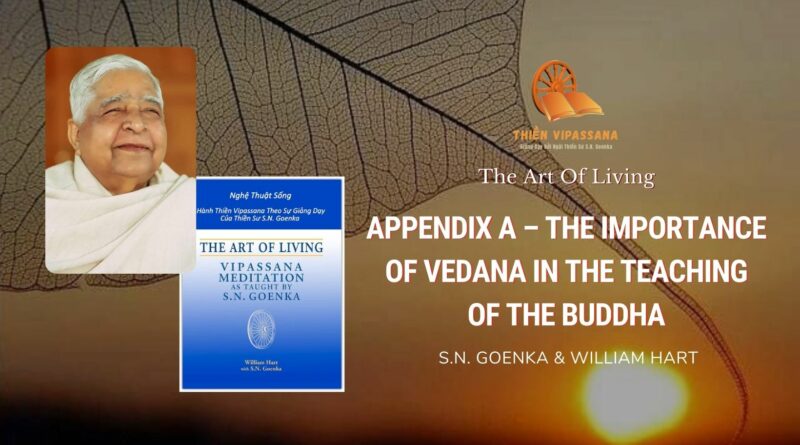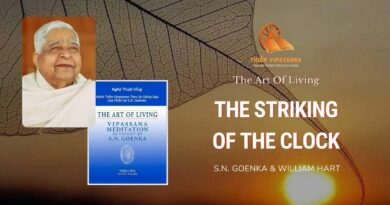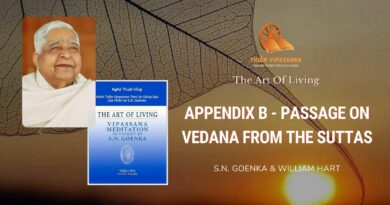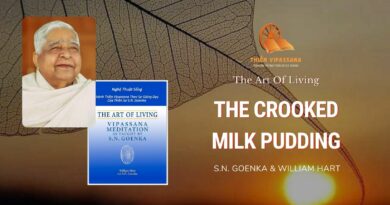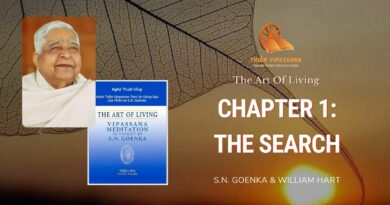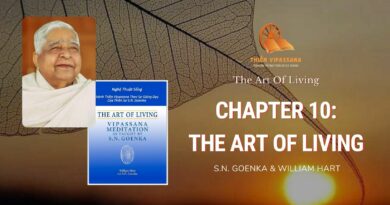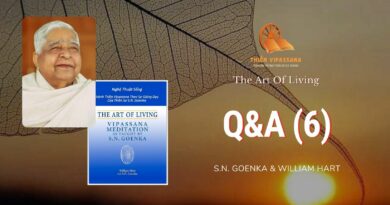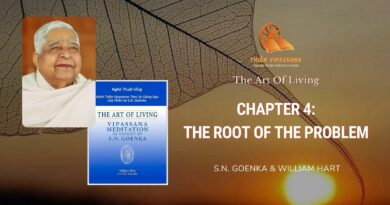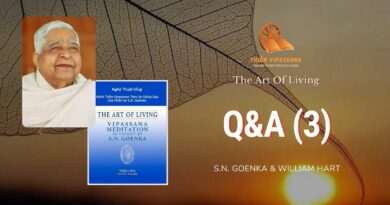Appendix A. THE IMPORTANCE OF VEDANĀ IN THE TEACHING OF THE BUDDHA
The teaching of the Buddha is a system for developing self-knowledge as a means to self-transformation. By attaining an experiential understanding of the reality of our own nature, we can eliminate the misapprehensions that cause us to act wrongly and to make ourselves unhappy. We learn to act in accordance with reality and therefore to lead productive, useful, happy lives.
In the Satipaṭṭhāna Sutta, the “Discourse on the Establishing of Awareness,” the Buddha presented a practical method for developing self-knowledge through self-observation. This technique is Vipassana meditation.
Any attempt to observe the truth about oneself immediately reveals that what one calls “oneself” has two aspects, physical and psychic, body and mind. We must learn to observe both. But how can we actually experience the reality of body and mind? Accepting the explanations of others is not sufficient, nor is depending on merely intellectual knowledge. Both may guide us in the work of self-exploration, but each of us must explore and experience reality directly within ourselves.
We each experience the reality of the body by feeling it, by means of the physical sensations that arise within it. With eyes closed we know that we have hands, or any of the other parts of the body, because we can feel them. As a book has external form and internal content, the physical structure has an external, objective reality—the body (kāya)—and an internal, subjective reality of sensation (vedanā). We digest a book by reading all the words in it; we experience the body by feeling sensations. Without awareness of sensations there can be no direct knowledge of the physical structure. The two are inseparable.
Similarly, the physic structure can be analyzed into form and content: the mind (citta) and whatever arises in the mind (dhamma)—any thought, emotion, memory, hope, fear, any mental event. As body and sensation cannot be experienced separately, so one cannot observe the mind apart from the contents of the mind. But mind and matter are also closely interrelated. Whatever occurs in one is reflected in the other. This was a key discovery of the Buddha, of crucial significance in his teaching. As he expressed it, “Whatever arises in the mind is accompanied by sensation.”1 Therefore observation of sensation offers a means to examine the totality of one’s being, physical as well as mental.
These four dimensions of reality are common to every human being: the physical aspects of body and sensation, the psychic aspects of mind and its content. They provide the four divisions of the Satipaṭṭhāna Sutta, the four avenues for the establishing of awareness, the four vantage points for observing the human phenomenon. If the investigation is to be complete, every facet must be experienced. And all four can be experienced by observing vedanā.
For this reason the Buddha specially stressed the importance of awareness of vedanā. In the Brahmajāla Sutta, one of his most important discourses, he said, “The enlightened one has become liberated and freed from all attachments by seeing as they really are the arising and passing away of sensations, the relishing of them, the danger of them, the release from them.”2 Awareness of vedanā, he stated, is a prerequisite for the understanding of the Four Noble Truths: “To the person who experiences sensation I show the way to realize what is suffering, its origin, its cessation, and the path leading to its cessation.”3
What exactly is vedanā? The Buddha described it in various ways. He included vedanā among the four processes that compose the mind (see Chapter Two). However, when defining it more precisely he spoke of vedanā as having both mental and physical aspects.4 Matter alone cannot feel anything if the mind is not present: in a dead body, for example, there are no sensations. It is the mind that feels, but what it feels has an inextricable physical element.
This physical element is of central importance in practising the teaching of the Buddha. The purpose of the practice is to develop in us the ability to deal with all the vicissitudes of life in a balanced way. We learn to do so in meditation by observing with equanimity whatever happens within ourselves. With this equanimity, we can break the habit of blind reaction, and instead can choose the most beneficial course of action in any situation.
Whatever we experience in life is encountered through the six gates of perception, the five physical senses and the mind. And according to the Chain of Conditioned Arising, as soon as a contact occurs at any of these six gates, as soon as we encounter any phenomenon, physical or mental, a sensation is produced (see above, p. 49). If we do not give attention to what happens in the body, we remain unaware, at the conscious level, of the sensation. In the darkness of ignorance an unconcious reaction begins toward the sensation, a momentary liking or disliking, which develops into craving or aversion. This reaction is repeated and intensified innumerable times before it impinges on the conscious mind. If meditators give importance only to what happens in the conscious mind, they become aware of the process after the reaction has occurred and gathered dangerous strength, sufficient to overwhelm them. They allow the spark of sensation to ignite a raging fire before trying to extinguish it, needlessly making difficulties for themselves. But if they learn to observe the sensations within the body objectively, they permit each spark to burn itself out without starting a conflagration. By giving importance to the physical aspect, they become aware of vedanā as soon as it arises, and can prevent any reactions from occurring.
The physical aspect of vedanā is particularly important because it offers vivid, tangible experience of the reality of impermanence within ourselves. Change occurs at every moment within us, manifesting itself in the play of sensations. It is at this level that impermanence must be experienced. Observation of the constantly changing sensations permits the realization of one’s own ephemeral nature. This realization makes obvious the futility of attachment to something that is so transitory. Thus the direct experience of anicca automatically gives rise to detachment, with which one can not only avert fresh reactions of craving or aversion, but also eliminate the very habit of reacting. In this way one gradually frees the mind of suffering. Unless its physical aspect is included, the awareness of vedanā remains partial and incomplete. Therefore the Buddha repeatedly emphasized the importance of the experience of impermanence through physical sensations. He said
Those who continually make efforts
to direct their awareness toward the body,
who abstain from unwholesome actions
and strive to do what should be done,
such people, aware, with full understanding,
The cause of suffering is taṇhā, craving and aversion. Ordinarily it appears to us that we generate reactions of craving and aversion toward the various objects that we encounter through the physical senses and the mind. The Buddha, however, discovered that between the object and the reaction stands a missing link: vedanā. We react not to the exterior reality but to the sensations within us. When we learn to observe sensation without reacting in craving and aversion, the cause of suffering does not arise, and suffering ceases. Therefore observation of vedanā is essential in order to practise what the Buddha taught. And the observation must be at the level of physical sensation if the awareness of vedanā is to be complete. With the awareness of physical sensation we can penetrate to the root of the problem and remove it. We can observe our own nature to the depths and can liberate ourselves from suffering.
By understanding the central importance of the observation of sensation in the teaching of the Buddha, one can gain fresh insight into the Satipaṭṭhāna Sutta.6 The discourse begins by stating the aims of satipaṭṭhāna, of establishing awareness: “the purification of beings; the transcending of sorrow and lamentation; the extinguishing of physical and mental suffering; the practising of a way of truth: the direct experience of the ultimate reality, nibbāna.”7 It then briefly explains how to achieve these goals: “Here a meditator dwells ardent with thorough understanding and awareness, observing body in body, observing sensations in sensations, observing mind in mind, observing the contents of the mind in the contents of the mind, having abandoned craving and aversion toward the world.”8
What is meant by “observing body in body, sensations in sensations” and so forth? For a Vipassana meditator, the expression is luminous in its clarity. Body, sensations, mind, and mental contents are the four dimensions of a human being. To understand this human phenomenon correctly, each of us must experience the reality of ourselves directly. To achieve this direct experience, the meditator must develop two qualities: awareness (sati) and thorough understanding (sampajañña). The discourse is called “The Establishing of Awareness,” but awareness is incomplete without understanding, insight into the depths of one’s own nature, into the impermanence of this phenomenon that one calls “I.” The practice of satipaṭṭhāna leads the meditators to realize their essentially ephemeral nature. When they have had this personal realization, then awareness is firmly established—right awareness leading to liberation. Then automatically craving and aversion disappear, not just toward the external world but also toward the world within, where craving and aversion are most deep-seated, and most often overlooked—in the unthinking, visceral attachment to one’s own body and mind. So long as this underlying attachment remains, one cannot be liberated from suffering.
The “Discourse on the Establishing of Awareness” first discusses observation of the body. This is the most apparent aspect of the mental-physical structure, and hence the proper point from which to begin the work of self-observation. From here observation of sensations, of mind, and of mental contents naturally develops. The discourse explains several ways to begin observing the body. The first and most common is awareness of respiration. Another way to begin is by giving attention to bodily movements. But no matter how one starts the journey, there are certain stages through which one must pass on the way to the final goal. These are described in a paragraph of crucial importance in the discourse:
In this way he dwells observing body in body internally or externally, or both internally and externally. He dwells observing the phenomenon of arising in the body. He dwells observing the phenomenon of passing away in the body. He dwells observing the phenomenon of arising and passing away in the body. Now the awareness presents itself to him, “This is body.” This awareness develops to such an extent that only understanding and observation remain, and he dwells detached without clinging to anything in the world.9
The great importance of this passage is shown by the fact that it is repeated not only at the end of each section within the discussion of observation of the body, but also within the succeeding divisions of the discourse dealing with the observation of sensations, of mind and of mental contents. (In these three later divisions, the word “body” is replaced by “sensations,” “mind,” and “mental contents” respectively.) The passage thus describes the common ground in the practice of satipaṭṭhāna. Because of the difficulties it presents, its interpretation has varied widely. However, the difficulties disappear when the passage is understood as referring to the awareness of sensations. In practising satipaṭṭhāna, meditators must achieve a comprehensive insight into the nature of themselves. The means to this penetrating insight is the observation of sensations, including as it does the observation of the other three dimensions of the human phenomenon. Therefore although the first steps may differ, beyond a certain point the practice must involve awareness of sensation.
Hence, the passage explains, meditators begin by observing sensations arising in the interior of the body or externally, on the surface of the body, or both together. That is, from awareness of sensations in some parts and not in others, they gradually develop the ability to feel sensations throughout the body. When they begin the practice, they may first experience sensations of an intense nature which arise and seem to persist for some time. Meditators are aware of their arising, and after some time of their passing away. In this stage they are still experiencing the apparent reality of body and mind, their integrated, seemingly solid and lasting nature. But as one continues practising, a stage is reached in which the solidity dissolves spontaneously, and mind and body are experienced in their true nature as a mass of vibrations, arising and passing away every moment. With this experience now one understands at last what body, sensations, mind, and mental contents really are: a flux of impersonal, constantly changing phenomena.
This direct apprehension of the ultimate reality of mind and matter progressively shatters one’s illusions, misconceptions, and preconceptions. Even right conceptions that had been accepted only on faith or by intellectual deduction now acquire new significance when they are experienced. Gradually, by the observation of reality within, all the conditioning that distorts perception is eliminated. Only pure awareness and wisdom remain.
As ignorance disappears, the underlying tendencies of craving and aversion are eradicated, and the meditator becomes freed from all attachments—the deepest attachment being to the inner world of one’s own body and mind. When this attachment is eliminated, suffering disappears and one becomes liberated.
The Buddha often said, “Whatever is felt is related to suffering.”10 Therefore vedanā is an ideal means to explore the truth of suffering. Unpleasant sensations are obviously suffering, but the most pleasant sensation is also a form of very subtle agitation. Every sensation is impermanent. If one is attached to pleasant sensations, then when they pass away, suffering remains. Thus every sensation contains a seed of misery. For this reason, as he spoke of the path leading to the cessation of suffering, the Buddha spoke of the path leading to the arising of vedanā, and that leading to its ceasing.11 So long as one remains within the conditioned field of mind and matter, sensations and suffering persist. They cease only when one transcends that field to experience the ultimate reality of nibbāna.
The Buddha said:
A man does not really apply Dhamma in life just because he speaks much about it.
But though someone may have heard little about it,
if he sees the Law of Nature by means of his own body, then truly he lives according to it,
and can never be forgetful of the Dhamma.12
Our own bodies bear witness to the truth. When meditators discover the truth within, it becomes real for them and they live according to it. We can each realize that truth by learning to observe the sensations within ourselves, and by doing so we can attain liberation from suffering.
Bài viết này được trích từ cuốn sách The Art Of Living – Thiền Sư S.N.Goenka và William Hart.

